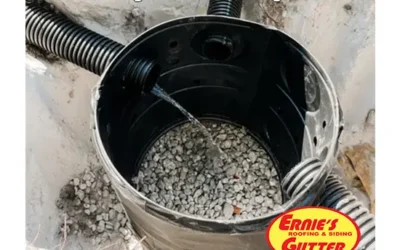Fix Rotted Fascia and Soffit Boards / Install Step Flashing in Denver
Learn how to fix rotted fascia and soffit boards while installing step flashing to protect your roof in Denver. Ernie’s Gutter, a third-generation contractor, has been delivering expert seamless gutter, roof repair, and gutter replacement services since 1978. Call 720-346-ROOF for expert services today.
If you’re a Denver homeowner dealing with rotted fascia or soffit boards, you’re not alone. Fascia and soffit boards are often overlooked, but they play a critical role in maintaining the structural integrity of your roof and gutter system. At Ernie’s Gutter, we’ve been helping the Denver community with seamless gutter installation, gutter replacement, and all sorts of roof repair services since 1978. So, if you’re noticing sagging gutters, peeling paint, or rotted wood around your roof’s edges, it’s time to get it fixed before it turns into a bigger problem.
Today, I’m going to walk you through how to fix rotted fascia and soffit boards while also installing essential step flashing. This fix will not only keep your roof looking great but will also protect your home from future water damage. We’ll cover everything from removing old gutters to ensuring the water is properly redirected into your downspouts, so your home stays dry and damage-free. Let’s dive in!
Why Fascia and Soffit Boards Matter
Fascia boards are the long, straight boards that run along the roof’s edge, providing support for the bottom edge of the roof tiles and the gutters. The soffit, on the other hand, is the material that bridges the gap between the edge of the roof and the wall. Together, these elements protect your home’s exterior from the weather and pests. However, without proper maintenance and flashing, water can seep into these areas, causing wood rot, peeling paint, and even mold inside your home.
In Denver, where we get a fair amount of snow and rain, having properly functioning gutters and flashing is even more critical. Flashing, especially step flashing, works to channel water away from critical areas of your roof and into your gutters. Without it, water will eventually make its way behind your walls, creating the perfect environment for rot and other problems. So if you’re already dealing with rotted fascia or soffit boards, or you want to prevent it, proper flashing is essential.
Getting Started: Removing the Old Gutters
If your fascia or soffit boards are rotting, there’s a good chance that your gutters aren’t in the best shape either. The first step in this repair process is to carefully remove your old gutters. Now, don’t worry—this may seem daunting, but with the right tools and approach, it’s a straightforward job.
Here at Ernie’s Gutter, we always start by unscrewing the gutter brackets and drilling out any rivets holding the sections together. This is typically a two-person job, depending on the length of your gutters. Once the gutters are down, you can take a closer look at the condition of your fascia and soffit. If you notice water marks or warping, it’s time to replace the damaged boards.
Pro Tip: While you have the gutters down, it’s a great opportunity to inspect the rest of your roofline and look for any other signs of damage or wear. Prevention is always cheaper than repair!
Removing and Replacing Rotted Fascia and Soffit Boards
With your gutters out of the way, the next step is removing the damaged sections of fascia and soffit. In most cases, it’s best to replace entire sections rather than trying to patch small areas. This ensures a cleaner, more seamless look and better protection in the long run. Use a pry bar to carefully remove the old boards, then inspect the exposed areas for any additional damage.
Once the old boards are removed, it’s crucial to seal any cut ends with a quality primer to prevent future rot. We recommend using durable, moisture-resistant materials like LP SmartSide or similar products. These materials are designed to hold up against Denver’s harsh weather conditions, providing you with long-lasting protection.
The Importance of Step Flashing
One of the biggest causes of rotted fascia and soffit boards is poor flashing around critical roof intersections. If you don’t have proper step flashing in place, water can seep into the gaps between your roof and walls, leading to rot, mold, and other damage.
Step flashing is installed in layers under the shingles, at the point where your roof meets vertical structures like walls or chimneys. Each piece of flashing is bent to direct water into the gutter system, preventing it from running down your walls and causing damage. It’s a small but incredibly important detail that many homes—especially older ones—often lack.
Pro Tip: If you’re unsure whether your home has proper step flashing, give us a call at Ernie’s Gutter. We offer free inspections to make sure your roof and gutter systems are working as they should.
Installing Seamless Gutters for Maximum Protection
Once the new fascia and soffit boards are installed, it’s time to put your gutters back up. We highly recommend upgrading to seamless gutters, which are custom-made to fit your home perfectly. Unlike traditional sectional gutters, seamless gutters don’t have joints that can weaken over time, making them much more resistant to leaks and clogs.
During the installation process, we ensure that the gutters are pitched correctly to direct water toward the downspouts. This might sound simple, but even a slight misalignment can lead to standing water and overflowing gutters. And in a city like Denver, where we often experience heavy snowmelt and rainstorms, that’s the last thing you want.
Tips for Long-Lasting Repairs
- Use Quality Materials: Always choose weather-resistant materials like galvanized nails and LP SmartSide for fascia and soffit replacements. These products are designed to withstand the elements and provide long-lasting protection.
- Seal and Prime Exposed Ends: Anytime you make cuts, especially on wooden materials, make sure to seal the exposed ends with primer and paint. This will prevent water from seeping in and causing future rot.
- Inspect Regularly: Denver’s weather can be tough on gutters and roofs. Regular inspections can help catch problems early before they turn into major repairs.
Table of Contents
- Introduction to Fascia and Soffit Board Repair
- Why Fascia and Soffit Boards Matter
- Getting Started: Removing the Old Gutters
- Removing and Replacing Rotted Fascia and Soffit Boards
- The Importance of Step Flashing
- Installing Seamless Gutters for Maximum Protection
- Tips for Long-Lasting Repairs
- FAQs About Fascia, Soffit, and Step Flashing
- Contact Ernie’s Gutter for Expert Repair Services
FAQs
1. What causes fascia and soffit boards to rot?
Fascia and soffit boards usually rot due to water damage from improperly installed gutters, lack of flashing, or clogged downspouts. In Denver, harsh weather conditions like snow and rain make these areas particularly vulnerable.
2. How do I know if my fascia or soffit needs replacing?
Signs that your fascia or soffit needs replacing include peeling paint, visible rot, sagging gutters, and water marks on the exterior of your home.
3. What is step flashing, and why is it important?
Step flashing is a series of metal pieces that are installed where the roof meets a vertical surface. It directs water into the gutters, preventing it from running down your walls and causing damage.
4. Can I replace just a section of rotted fascia or soffit?
While it’s possible to replace just a section, it’s usually better to replace the entire length to ensure a seamless look and prevent further water infiltration.
5. How long do fascia and soffit repairs take?
For an average home, replacing fascia, soffit boards, and installing new step flashing can take anywhere from one to three days, depending on the extent of the damage.
6. How often should I inspect my gutters and roofline?
You should inspect your gutters and roofline at least twice a year, ideally in the spring and fall. Regular inspections help catch minor issues before they turn into costly repairs.
7. Why should I choose seamless gutters over sectional gutters?
Seamless gutters have fewer joints, which means fewer places for water to leak. They are custom-made to fit your home, providing a cleaner, more efficient drainage system.
8. Can I install step flashing myself?
Installing step flashing requires some roofing knowledge, and it’s critical that it’s done correctly to prevent leaks. If you’re not experienced with roofing repairs, it’s best to hire a professional.
9. What kind of materials should I use for fascia and soffit boards?
For the Denver climate, we recommend using moisture-resistant materials like LP SmartSide or cedar, and make sure to use galvanized nails to prevent rust.
10. How can I prevent future rot in my fascia and soffit?
The best way to prevent future rot is to ensure that your gutters are functioning properly, install step flashing to redirect water, and keep up with regular maintenance.
OUR SERVICES
Your Neighborhood Roofing Contractor
Get more information concerning our service, do not wait to call us at 720 346 ROOF today. We’ll be more than happy to schedule a meeting with you.
Residential Roofing Contractor
Ernie’s Roofing specialize in residential roofing in Denver and have a team of experienced professional Roofers available to help you get the job done right The First Time. From minor repairs and maintenance to full–scale roof replacements,

Commercial Roofing
We construct, repair, as well as maintain Commercial Roofing systems for services both large and also small, creating personalized services that conserve our client’s time, cash, and also power. Call us at 720 346 ROOF and book a consultation today.

Hail Damage
Their knowledgeable staff is ready to help you assess the damage caused by storms and provide you with a comprehensive repair evaluation & plan. We specialize in all types of roof damage, including hail, wind, and even lightning strikes. Hail Claim Help

INSURANCE CLAIMS HELP
Our team of experienced insurance claim specialists will work with you to ensure that the insurance claim process is as stress-free as possible. We will work with your insurance company to provide all necessary documentation and estimates to ensure that your claim is processed quickly and correctly.

Wind Damage
When it comes to roof damage, it can be difficult to determine whether the damage was caused by hail or wind. While both types of damage can cause similar symptoms, they have different causes and require different repair methods.
What’s New on The Blog
New Gutter Guard Cost In 2025
Gutter Guard CostLatest News & Resources When you need a roof contractor you can rely on the team of experts at Ernie's Roofing. We specialize in a wide range of services from new construction, maintenance, and repairs for your home or business.New Gutter Guard...
Water Drainage & Storm Damage Solutions
Water Drainage & Storm Damage SolutionsLatest News & Resources When you need a roof contractor you can rely on the team of experts at Ernie's Roofing. We specialize in a wide range of services from new construction, maintenance, and repairs for your home or...
Custom Seamless Gutter Installation
Seamless Gutter InstallationLatest News & Resources When you need a roof contractor you can rely on the team of experts at Ernie's Roofing. We specialize in a wide range of services from new construction, maintenance, and repairs for your home or business.Why...
#1 Home Improvement Services
Craftsmanship That Stands Like a House
Let’s Get Your Project on the Right Track
Let’s Get Started
Ready to speak with an expert ?






